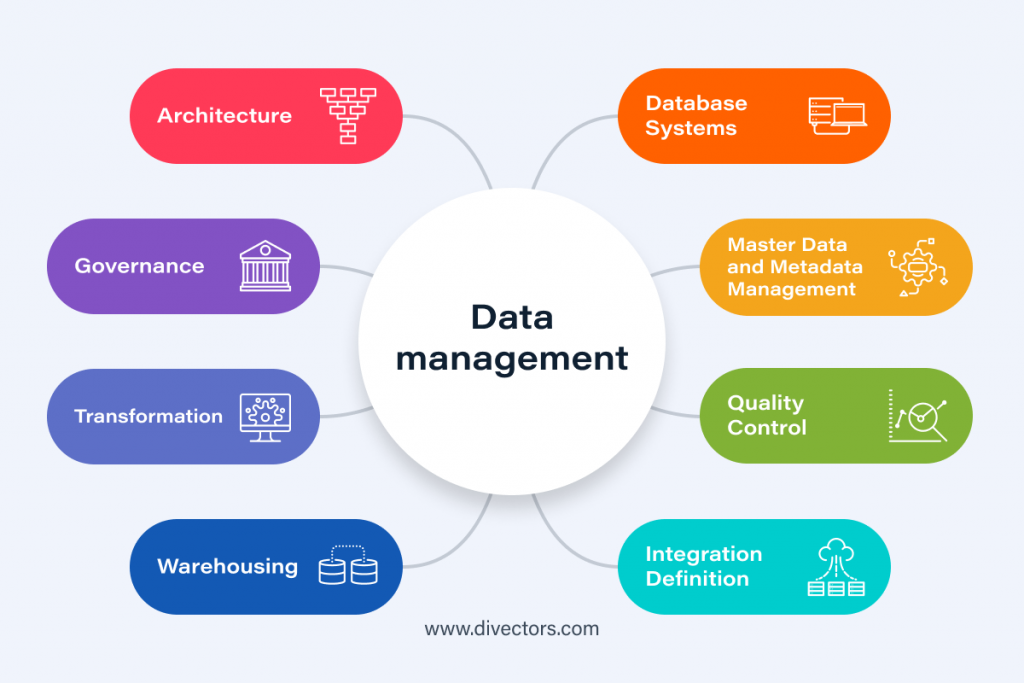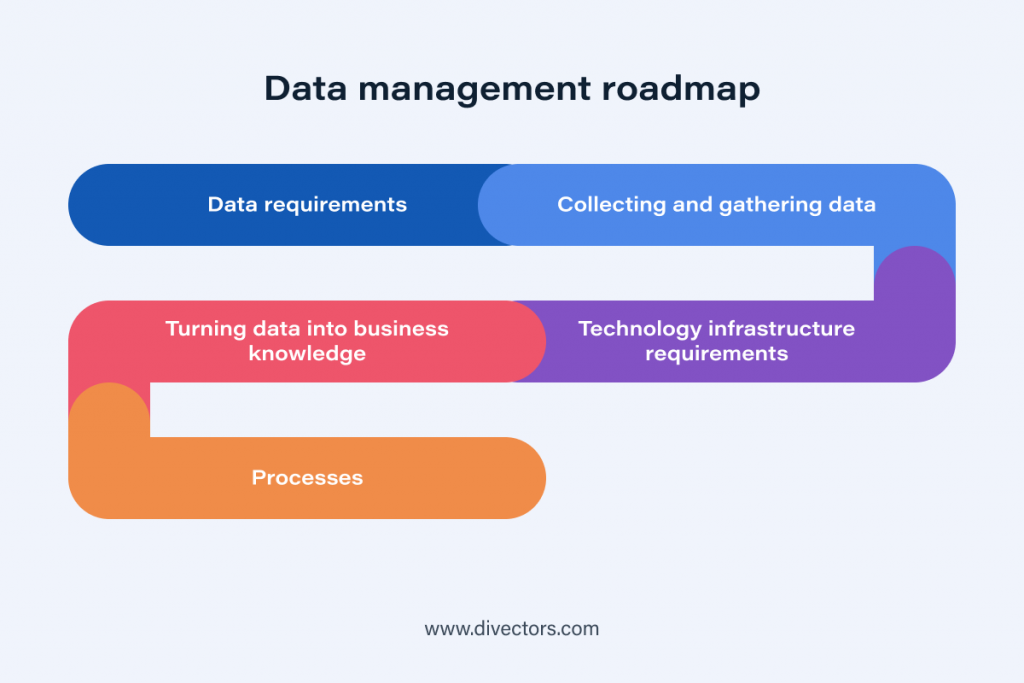Establishing data management strategy for your company: why and how
Today companies produce huge amounts of data, most of them have different storages or even data lakes. However the real profit from the data is not always realized to the full potential. But with a proper data acquisition and correct data management, companies can focus on understanding of their own business and use the data they possess to their advantage.

What is data management and why it’s important
Data management is the process that involves gathering, validating, and using data in a way that is secure, effective, and efficient. For businesses, the tendency to overlook and underestimate the importance and value of data management usually comes with a price. And here’s why.
Redundant and unmanaged data leads to inefficiencies and inconsistencies on the reporting layer. This, in turn, leads to high costs for reporting, because each time when data is modified, the action must be performed in more than one place. Possible inconsistencies reduce the quality of the data and business users lose trust in data. Also ultimately, companies are paying high costs for housing redundant data.

So what is the first step you should take in managing data for your firm, you might ask? We believe that the key to solving all these issues and turning company data into business knowledge is the establishment of a company’s data management strategy.
Data management principles
First, let’s try and establish the key principles of data management, which are:
- Data is an asset with unique properties.
- The value of data can and should be expressed in economic terms: Data strategy should also consider measuring costs of low quality data and the benefits of high quality data.
- Managing data means managing the quality of data: Ensuring that data is fit for purpose is a primary goal of data management. To manage quality, organizations must ensure they understand stakeholders’ requirements for quality and measure data against these requirements.
- It takes Metadata to manage data: Managing any asset requires having data about that asset (number of employees, accounting codes, etc.). The data used to manage and use data is called Metadata.
We were approached by Virgin Mobile Middle East & Africa to assist them with several critical challenges:
- Lack of an integrated, consistent metadata repository that would provide business units with accessible information for analytical purposes.
- Absence of a data governance framework, resulting in unclear data ownership, business glossary, and data management processes across IT and business units.
- Data quality issues being treated on an ad-hoc basis without effective governance, requiring extensive manual work to resolve and understand the root causes.
Data management roadmap
Data Management strategy is a roadmap that defines People, Processes, and Technology.

1. Data requirements
Data must address specific business needs in order to achieve strategic goals and generate real value. The first step of defining the business requirements is to identify a champion, all stakeholders, and SMEs in the organization. Stakeholders and other SMEs will represent specific departments or functions within the company.
2. Collecting and gathering data
Sources of data need to be analyzed and profiled. There is a need to determine whether the data has the right level of detail and is updated with the right frequency to answer business questions effectively.
3. Technology infrastructure requirements
The main questions you should be asking to understand the company’s infrastructure requirements are:
- Does the organization have the skills and technical infrastructure to support data storage and processing on-prem, or would leveraging a cloud-based solution make more sense?
- Where the data doesn’t exist today, how will the gaps be filled? Can the data be calculated or estimated?
- Is there a standard integration approach to get the data from source systems into the central repository? What number of data layers needs to be in place from the architectural perspective?
4. Turning data into business knowledge
A Data Strategy should provide an understanding of how to apply analytics to the data assets, Extracting insights automatically (generation reports, self-service reporting) and data visualization is a key. Some companies still rely on legacy tools that don’t allow interaction and visualization. Often, a manual process is required to create reports and deliver them to the business.
5. Processes
Business processes may need to be re-engineered to incorporate data analysis. This can be achieved by documenting the steps in a process and where specific reports are leveraged for a decision. We can also mandate that specific data be provided as a rationale for a business decision.
Challenges you might encounter
1. Metadata management
Metadata management can be divided into business, technical, and operational areas. The goal is to build a single repository with all company terms, definitions, descriptions of policies, entities terms clearly explained. It allows the creation of a business-level glossary for the enterprise, and if necessary, specialization of certain terms at the organizational level.
If metadata is not managed during the system lifecycle, silos of inconsistent metadata will be created in the organization that does not meet any team’s full needs and provides conflicting or confusing information. Users would not know how much they need to trust the data
2. Data quality
Ensuring that data is of high quality is central to data management. Organizations manage their data because they want to use it. If they cannot rely on it to meet business needs, then the effort to collect, store, secure, and enable access to it is wasted. To ensure data meets business needs, they must work with data consumers to define these needs, including characteristics that make data of high quality. Managing Data Quality is not a one-time job. Producing high-quality data requires planning, commitment, and a mindset that builds quality into processes and systems. Poor quality data is simply costly to any organization. Costs of poor-quality data could be hidden, indirect, and therefore hard to measure. Others, like fines, are direct and easy to calculate.
3. Data lineage
Data lineage requires documenting the origin of data sets, as well as their movement and transformation through systems where they are accessed and used. The better an organization understands the lifecycle and lineage of its data, the better able it will be to manage its data.
4. Data lifecycle
The data lifecycle is based on the product life cycle. Data may be cleansed, transformed, merged, enhanced, or aggregated. Companies that apply data lifecycle management and ensure good handling of the information that they generate in their everyday operations have several advantages, which include:
- An adequate data lifecycle management strategy allows for requirements to be implemented by each industrial sector for data storage to be met.
- It guarantees a good data protection infrastructure, which helps toward their safety in case of a risk or an emergency. This applies both to in-house information and customer data that the company works with.
- The extraction and maintenance of information throughout the data lifecycle allow updated values to always be available.
Availability of clean, useful, precise data that is available to all users. This increases the agility and efficiency of company processes.
Building a modern data management strategy
Applying all of the above-mentioned practices, and initiatives, and building modern data management can make your business more effective. Data management platform enabling data processing allows for building smart solutions and is a solid base for business intelligence and ad-hoc reporting.
Interested? We know how to implement data strategy and make your company data-driven, contact Divectors for more details

